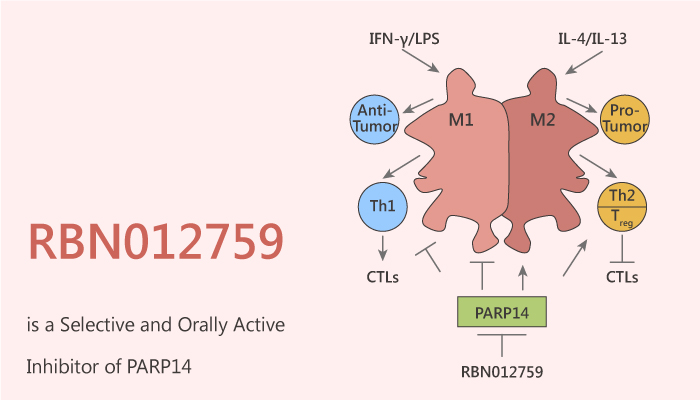Poly (ADP ribose) polymerase (PARP) is a family of proteins involved in many cellular processes, such as DNA repair, genomic stability, and programmed cell death. Specifically, PARP consists of four target domains: DNA-binding domain, caspase-cleaved domain, self-modifying domain, and a catalytic domain. Besides, the main role of PARP is to detect and initiate an immediate cellular response to metabolic, chemical or radiation-induced single-strand breaks (SSBs). Moreover, it acts by signaling enzyme mechanisms involved in SSB repair. The complete PARP14 consists of macro1, macro2, macro3, WWE, and a catalytic domain. Furthermore, PARP14 uses nicotinamide adenine dinucleotide (NAD+) as a metabolic substrate to modify the target protein by single ADP ribosylation. So, PARP14 participates in the cellular response and signal transduction pathway in the immune system. Therefore, PARP14 is an attractive target for the treatment of cancer and allergic inflammation. RBN012759 is a potent, selective, and orally active inhibitor of PARP14.

RBN012759 is a potent, selective, and orally active PARP14 inhibitor.
How does brd3308 work on the target? Let’s study it together. In the beginning, RBN012759 is a potent, selective, and orally active inhibitor of PARP14, with an IC50 of <3 nM. Meanwhile, RBN012759 displays 300-fold selectivity over the monoPARPs and 1000-fold selectivity over the polyPARPs. Nonetheless, RBN012759 decreases pro-tumor macrophage function and elicits inflammatory responses in tumor explants.
In the second place, RBN012759, with 0.01-10 μM, decreases the MAR/PAR signal corresponding to PARP14 self MARylation. Importantly, RBN012759 stabilizes PARP14 protein in a dose-dependent manner in human primary macrophages. Particularly, RBN012759 reduces IL-4 stimulated cytokine secretion in human primary macrophages.
Last but not the least, RBN012759, with 500 mg/kg BID by p.o., is well-tolerated in mice with repeat dosing. Obviously, RBN012759 with 100 mg/kg by p.o., exhibits moderate orally bioavailability (30%) and short plasma half-life (0.4 h). RBN012759 has moderate clearance (54 mL/min/kg) and low steady-state volume of distribution (1.4 L/kg) in mice.
All in all, RBN012759 is a potent, selective, and orally active PARP14 inhibitor.
References:
Schenkel L, et, al. AACR Annual Meeting 2020.